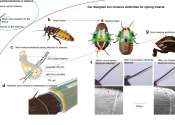A cyborg is a being with both biological and artificial (e.g. electronic, mechanical or robotic) parts. The term was coined in 1960 when Manfred Clynes and Nathan S. Kline used it in an article about the advantages of self-regulating human-machine systems in outer space. D. S. Halacy's Cyborg: Evolution of the Superman in 1965 featured an introduction which spoke of a "new frontier" that was "not merely space, but more profoundly the relationship between 'inner space' to 'outer space' – a bridge...between mind and matter."
The term cyborg is often today applied to an organism that has enhanced abilities due to technology, though this perhaps oversimplifies the necessity of feedback for regulating the subsystem. The earlier and more strict definition of Cyborg was almost always considered as increasing or enhancing normal capabilities, whereas now the term can also be applied to those organisms which use technology to repair or overcome their physical and mental constraints: including artificial limbs and hands as well as a device for helping colour-blind people to "hear" in colour. While cyborgs are commonly thought of as mammals, they might also conceivably be any kind of organism and the term "Cybernetic organism" has been applied to networks, such as road systems, corporations and governments, which have been classed as such. The term can also apply to micro-organisms which are modified to perform at higher levels than their unmodified counterparts.
Fictional cyborgs are portrayed as a synthesis of organic and synthetic parts, and frequently pose the question of difference between human and machine as one concerned with morality, free will, and empathy. Fictional cyborgs may be represented as visibly mechanical (e.g. the Cybermen in the Doctor Who franchise or The Borg from Star Trek); or as almost indistinguishable from humans (e.g. the Terminators from the Terminator films, the "Human" Cylons from the re-imagining of Battlestar Galactica etc.) The 1970s television series The Six Million Dollar Man featured one of the most famous fictional cyborgs, referred to as a bionic man. Cyborgs in fiction often play up a human contempt for over-dependence on technology, particularly when used for war, and when used in ways that seem to threaten free will. Cyborgs are also often portrayed with physical or mental abilities far exceeding a human counterpart (military forms may have inbuilt weapons, among other things).








